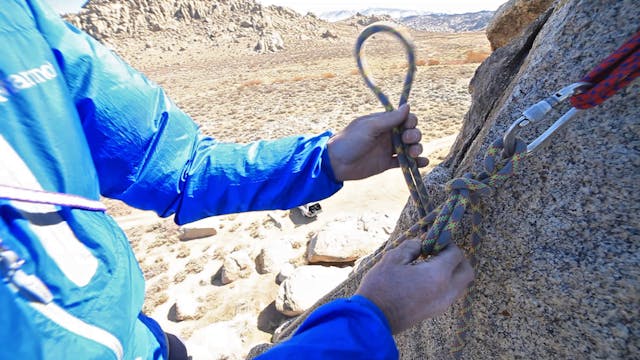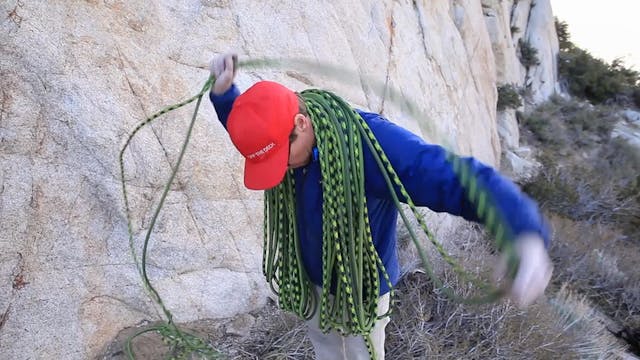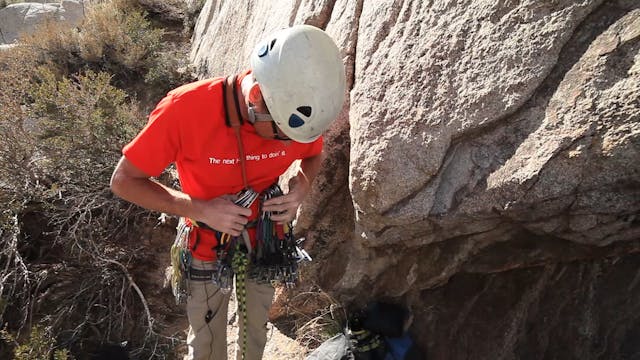Basic & Intermediate Outdoor Climbing: 13. Cleaning a Top Rope Anchor & Rappelling with a Backup
Basic & Intermediate Outdoor Climbing
•
5m 48s
In this video we review how to clean a top rope anchor and rappel back to the ground when you have finished climbing a route. For this, you must have a proper rappel station with rings at the top of the climb. If not, be prepared to leave gear behind.
Step 1: Properly secure yourself into the anchor’s master point.
There are many ways to accomplish this step:
-Use a single- or double-length sling girth-hitched to your harness, and clipped to the master point with a locking carabiner.
-Use a Personal Anchor System (PAS) instead of a sling, as above (a daisy chain is not appropriate here, as it is specifically designed for aid climbing and improper use can put the climber at risk)
NOTE: In this method, the climber cannot use the rope to connect to the anchor (i.e. with a clove hitch) because they will need to untie and thread the end of the rope through the rappel rings.
KEY CONSIDERATIONS:
-Girth hitch your sling or PAS to the belay loop or both tie in loops on your harness. Gear loops are not rated for the weight of a climber.
-Make sure there is minimal slack in your PAS or sling attached to the anchor. If you have slack in that sling and you slip, you will shock load the anchor and your sling, potentially putting maximal forces on the anchor and your sling.
-Even more important, while clipped in with your sling/PAS, do not climb above the anchor, if you were to slip in this case, you can shock load your anchor with an even greater force.
Step 2: Tell your belayer that you are “off belay.” See our verbal command video for more on this process.
IMPORTANT NOTE: Have a plan for cleaning the anchor before you leave the ground. Changing plans while distanced from your belayer can make communication difficult and has resulted in tragic accidents.
Step 3: Pull up several feet of slack and tie a knot. Clip this knot to your belay loop so you don’t drop your rope.
Step 4: Untie from the end of the rope and remove the figure eight.
Step 5: Thread the rope through the rappel rings. If there is not a proper rappel station with rings or chains, be prepared to leave carabiners behind.
Step 6: With a firm grip on the rope, untie the knot clipped to your harness (the one that was there to prevent dropping) and continue threading the rope until you can see or somehow verify that both ends of rope are on the ground.
NOTE: you may want to put knots in both ends of your rope, especially if you can’t see them on the ground.
Step 7: Set up your belay device for a rappel. See previous video for more on “How to Back Up the Rappel".
Step 8: Unclip your sling or PAS from the anchor.
Step 9: Retrieve the top rope anchor materials, clipping the carabiners and slings or cordelette to your gear loops.
Step 10: Rappel to the ground, keeping an eye on the rope below you to further mitigate the notorious risk of rappelling off the ends of your rope. Cultivating these kinds of good habits is one of the best ways to ensure a long and enjoyable climbing career.
NOTE: In this method, it is okay to go off belay because you are going to rappel. If you plan to be lowered, do not go off belay. Instead, clip yourself in as above, and ask your belayer for slack. Then thread the end through the rings and tie back in, all without going off belay. This is only appropriate on thick steel rings/chains. Be sure lowering off fixed gear is ethically appropriate at your crag.
We hope you found this video helpful. Feel free to comment below with questions or thoughts!
Please remember, climbing is inherently dangerous. Climb at your own risk.
Up Next in Basic & Intermediate Outdoor Climbing
-
Basic & Intermediate Outdoor Climbing...
In this video we review how to tie the munter hitch, and then tie it off with the munter mule knot. A munter hitch can be used as a belay, in the case of a forgotten or dropped belay device. The mule is a way to tie off the munter to go hands free, fixing the line in place.
Step 1: Clip a lock...
-
Basic & Intermediate Outdoor Climbing...
In this video we review how to coil the rope using a butterfly coil. This is a great coil for carrying the rope like a backpack and is very useful when walking down from a multi pitch climb or walking off the top of a crag after top-roping.
Step 1: Line up both ends of the rope and measure two...
-
Basic & Intermediate Outdoor Climbing...
In this video we look at ways for the lead climber to rack for their climb. Here are a few tips from our pros:
1. First, consult a guidebook, topo, or other climbers to find out what sizes and types of gear you need to safely protect the route.
2. Shoulder length slings can be worn over you...


